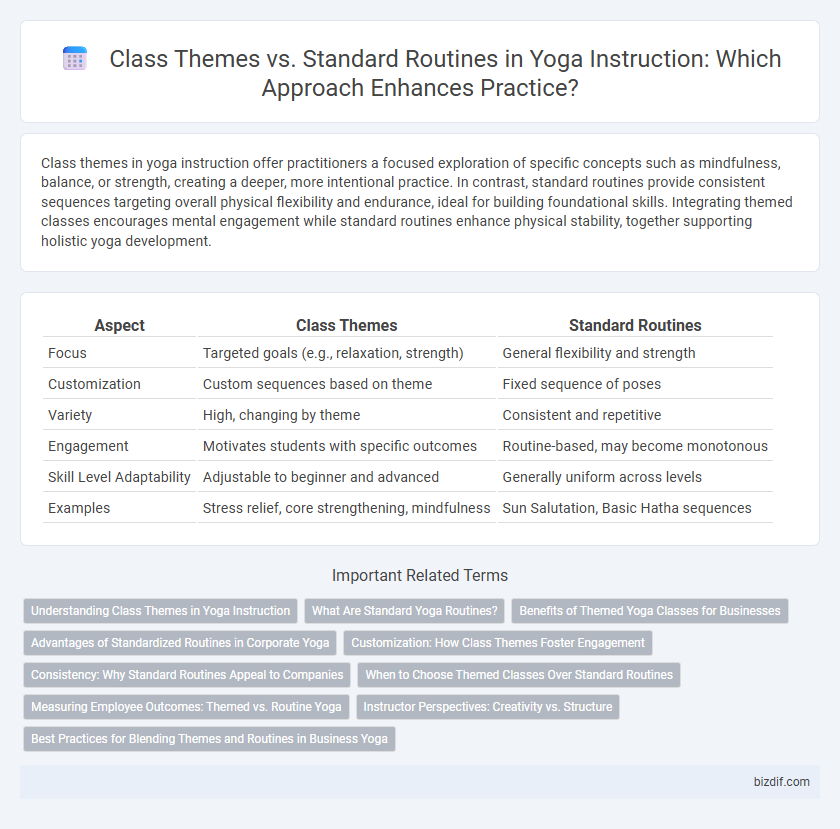Class themes in yoga instruction offer practitioners a focused exploration of specific concepts such as mindfulness, balance, or strength, creating a deeper, more intentional practice. In contrast, standard routines provide consistent sequences targeting overall physical flexibility and endurance, ideal for building foundational skills. Integrating themed classes encourages mental engagement while standard routines enhance physical stability, together supporting holistic yoga development.
Table of Comparison
| Aspect | Class Themes | Standard Routines |
|---|---|---|
| Focus | Targeted goals (e.g., relaxation, strength) | General flexibility and strength |
| Customization | Custom sequences based on theme | Fixed sequence of poses |
| Variety | High, changing by theme | Consistent and repetitive |
| Engagement | Motivates students with specific outcomes | Routine-based, may become monotonous |
| Skill Level Adaptability | Adjustable to beginner and advanced | Generally uniform across levels |
| Examples | Stress relief, core strengthening, mindfulness | Sun Salutation, Basic Hatha sequences |
Understanding Class Themes in Yoga Instruction
Class themes in yoga instruction enhance student engagement by providing focused intentions such as mindfulness, heart-opening, or balance. Unlike standard routines that emphasize repetitive sequences, themed classes foster deeper mental and emotional connections through tailored poses and affirmations. Understanding class themes allows instructors to create transformative experiences that align physical practice with holistic well-being goals.
What Are Standard Yoga Routines?
Standard yoga routines consist of set sequences of postures designed to improve flexibility, strength, and balance, typically following traditional frameworks such as Hatha, Vinyasa, or Ashtanga styles. These routines emphasize consistent practice of foundational poses like Downward Dog, Warrior series, and Sun Salutations to build body awareness and breath control. Unlike class themes that target specific intentions or challenges, standard routines maintain a balanced structure aimed at overall physical and mental well-being.
Benefits of Themed Yoga Classes for Businesses
Themed yoga classes offer businesses tailored experiences that enhance employee engagement and promote a focused wellness culture. By integrating specific themes such as stress relief, mindfulness, or strength building, these classes address targeted health goals, resulting in increased productivity and reduced workplace stress. Unlike standard routines, themed sessions provide varied, purpose-driven practices that foster long-term participation and improve overall organizational well-being.
Advantages of Standardized Routines in Corporate Yoga
Standardized routines in corporate yoga ensure consistent delivery of foundational postures and breathing techniques, promoting uniform physical and mental benefits across employees. These routines facilitate easier measurement of progress and adaptation to workplace wellness goals by maintaining structure and predictability. Emphasizing standardized sequences reduces planning time for instructors, allowing focused improvements in posture alignment and stress reduction tailored to corporate environments.
Customization: How Class Themes Foster Engagement
Class themes in yoga instruction elevate engagement by tailoring sessions to specific intentions, such as stress relief or strength building, enhancing student connection and motivation. Unlike standard routines, which follow a repetitive sequence, themed classes incorporate varied poses and mindful practices aligned with the chosen focus, promoting deeper immersion and personalized experience. Customization through class themes supports diverse skill levels and goals, fostering inclusivity and sustained participation among practitioners.
Consistency: Why Standard Routines Appeal to Companies
Standard routines provide companies with consistent structure, enabling clear performance tracking and measurable progress for employees. These routines simplify scheduling and resource allocation, ensuring reliable delivery of yoga sessions. Their predictability fosters employee engagement through familiarity and routine, enhancing long-term commitment to wellness programs.
When to Choose Themed Classes Over Standard Routines
Themed yoga classes target specific goals such as stress relief, strength building, or mindfulness, offering tailored sequences that enhance focus and motivation. Standard routines provide consistent, balanced practice beneficial for general fitness and foundational skill development. Opt for themed classes when seeking targeted outcomes or variety to deepen practice, while standard routines suit those favoring predictable structure and steady progress.
Measuring Employee Outcomes: Themed vs. Routine Yoga
Measuring employee outcomes in themed yoga classes versus standard routines reveals distinct benefits; themed classes increase engagement and reduce stress by aligning sessions with specific wellness goals, while routine yoga emphasizes consistency and skill development. Data indicates that employees participating in themed yoga report higher satisfaction and improved mental clarity compared to those in routine sessions. Quantitative metrics such as reduced absenteeism and enhanced productivity correlate strongly with the personalized focus of themed yoga instruction.
Instructor Perspectives: Creativity vs. Structure
Yoga instructors often balance creative class themes with standard routines to enhance student engagement and retention. Creative themes foster exploration and adaptability, allowing instructors to address specific intentions or seasonal influences. Structured routines provide consistency and safety, ensuring foundational alignment and progression for practitioners at varying skill levels.
Best Practices for Blending Themes and Routines in Business Yoga
Integrating class themes with standard yoga routines enhances student engagement by creating a cohesive and purposeful practice that aligns with their goals. Best practices include selecting themes that complement the physical flow, maintaining consistent pacing, and incorporating thematic elements through breathwork, meditation, or intentional language. This strategic blending fosters client retention, enriches the studio's brand, and supports instructors in delivering more impactful, personalized yoga experiences.
Class themes vs Standard routines Infographic

 bizdif.com
bizdif.com